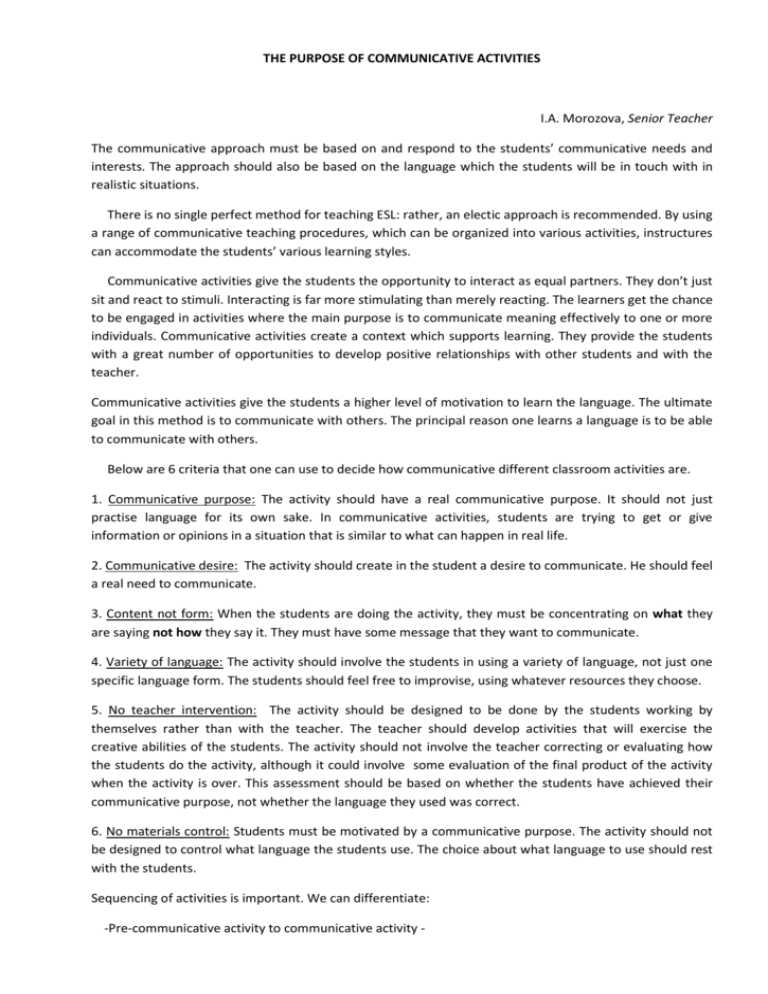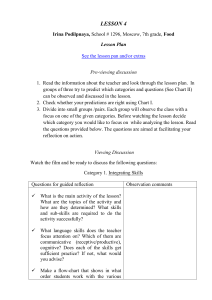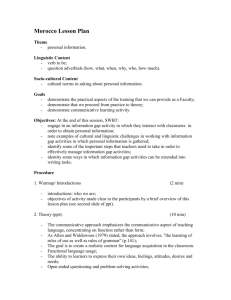THE PURPOSE OF COMMUNICATIVE ACTIVITIES
advertisement

THE PURPOSE OF COMMUNICATIVE ACTIVITIES I.A. Morozova, Senior Teacher The communicative approach must be based on and respond to the students’ communicative needs and interests. The approach should also be based on the language which the students will be in touch with in realistic situations. There is no single perfect method for teaching ESL: rather, an electic approach is recommended. By using a range of communicative teaching procedures, which can be organized into various activities, instructures can accommodate the students’ various learning styles. Communicative activities give the students the opportunity to interact as equal partners. They don’t just sit and react to stimuli. Interacting is far more stimulating than merely reacting. The learners get the chance to be engaged in activities where the main purpose is to communicate meaning effectively to one or more individuals. Communicative activities create a context which supports learning. They provide the students with a great number of opportunities to develop positive relationships with other students and with the teacher. Communicative activities give the students a higher level of motivation to learn the language. The ultimate goal in this method is to communicate with others. The principal reason one learns a language is to be able to communicate with others. Below are 6 criteria that one can use to decide how communicative different classroom activities are. 1. Communicative purpose: The activity should have a real communicative purpose. It should not just practise language for its own sake. In communicative activities, students are trying to get or give information or opinions in a situation that is similar to what can happen in real life. 2. Communicative desire: The activity should create in the student a desire to communicate. He should feel a real need to communicate. 3. Content not form: When the students are doing the activity, they must be concentrating on what they are saying not how they say it. They must have some message that they want to communicate. 4. Variety of language: The activity should involve the students in using a variety of language, not just one specific language form. The students should feel free to improvise, using whatever resources they choose. 5. No teacher intervention: The activity should be designed to be done by the students working by themselves rather than with the teacher. The teacher should develop activities that will exercise the creative abilities of the students. The activity should not involve the teacher correcting or evaluating how the students do the activity, although it could involve some evaluation of the final product of the activity when the activity is over. This assessment should be based on whether the students have achieved their communicative purpose, not whether the language they used was correct. 6. No materials control: Students must be motivated by a communicative purpose. The activity should not be designed to control what language the students use. The choice about what language to use should rest with the students. Sequencing of activities is important. We can differentiate: -Pre-communicative activity to communicative activity - Students move from shorter activities where a very narrow range of items are practised to a comprehensive activity in which they have to consolidate the new information taught with all that they have learned previously. Students move from controlled to creative activities, from small parts to the whole. The aim of a pre-communicative activity is to gain control of linguistic forms. -Communicative activity to pre-coommunicative activity – Students perform, for example, a role-play of a situation they might encounter without any lead-up activities. From this role-play, the teacher can diagnose areas which need further practice. Also, the students can see what their needs are. On the basis of the teacher’s diagnosis and perhaps after a discussion with the students about their needs, the teacher can organise controlled practice of the items which would help the students communicate more effectively or appropriately. This would be followed by other communicative activities which give the students a chance to practise the new items taught. This method is more effective with intermediate and advanced students and it is very effective for convincing students of the necessity of practising particular language items. While practising different kinds of activities we must always remember: initially, the aim of a communicative activity is to focus more on meaning than on form. The message can be understand even if there are some errors in the form. Obtaining correct meaning and correct form is the ultimate goal.







